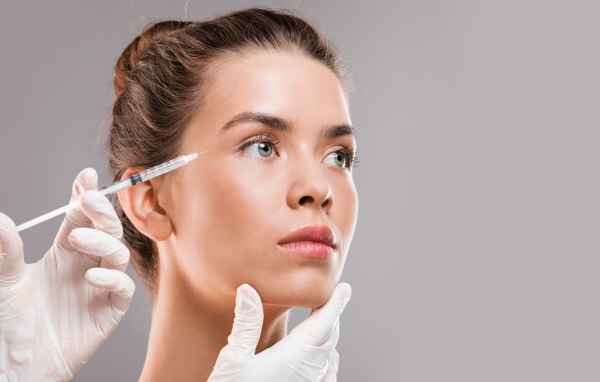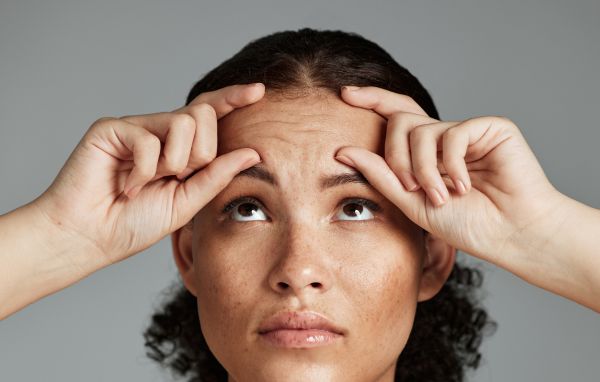Botox has become a modern-day fountain of youth, a beacon for those seeking to renew their visage. It promises a reduction in wrinkles and a boost in confidence. However, precision in its application is critical to achieving the desired aesthetic outcomes:
The landscape of facial anatomy is intricate and unforgiving. A slip or misjudgment can lead to unintended consequences. When it comes to using neurotoxins in Botox, it is important to exercise caution and follow proper guidelines.
As of my knowledge cutoff date, the field of cosmetic procedures places an unwavering emphasis on safety and efficacy, solidifying the importance of understanding not just where, but also where not to inject Botox.

Risk Zones for Botox Injections
When considering Inject Botox for wrinkle reduction, it’s imperative to recognize areas that are considered high-risk due to their proximity to vital structures. In the realm of facial aesthetics, certain risk zones demand a meticulous approach. The area around the eyes, for instance, requires precision due to the orbicularis oculi muscle’s role in controlling eyelid movement; an imprecise injection might lead to ptosis, an unintentional drooping of the eyelid. Similarly, injections near the mouth must be approached with caution to avoid compromising the muscles responsible for facial expressions, which can result in asymmetry or difficulty with speech and eating. Trusting a highly skilled professional who understands the nuances of facial anatomy is paramount to ensure the safety and efficacy of the procedure, while maintaining the desired aesthetic outcome.
Eye Area Complexities
The eye region is delicate—requiring expert knowledge and precision to avoid adverse outcomes after Botox treatment.
Inject Botox, if improperly placed, can lead to ptosis, a condition characterized by drooping of the eyelid, affecting visual function.
In particular, a practitioner must avoid the levator palpebrae superioris muscle, which is critical for eyelid elevation; otherwise, a patient may experience unwanted drooping, compromising their appearance and, potentially, their vision.
Employing Botox near the eye demands respect for the intricate muscular structure—avoiding the danger zones is crucial to preserving both aesthetics and the essential functions of the eye.
Temple Region Cautions
Inject Botox injections in the temple region warrant meticulous consideration due to the intricacy of the underlying structures.
- Avoid the superficial temporal artery, to prevent unintentional vascular compromise or Botox spread to unintended areas.
- Steer clear of the temporal branch of the facial nerve, as inadvertent involvement could lead to asymmetry in facial movements.
- Exercise caution around the zygomaticotemporal nerve, to avoid undesired numbness or pain post-procedure.
- Do not inject botox too deeply, as this may impact the temporalis muscle, altering jaw function and potentially causing headaches. The precision in administering Botox in the temple area is imperative to avoid complications and achieve the desired esthetic results. Erroneous injections in this region are not uncommon and can have pronounced implications, from aesthetic deficits to functional impairments.
Forehead or Brow Complications
Precise placement is crucial in the forehead region.
When considering inject Botox injections in the forehead. One must be cognizant of the delicate balance between muscle relaxation for wrinkle reduction and maintaining natural facial expressions. Overzealous injection or incorrect placement can lead to an undesirable drooping of the brow area, known as brow ptosis. Additionally, inappropriate doses or points of injection can adversely affect the overall symmetry of the face, as the forehead plays a pivotal role in facial aesthetics.
Avoid overtreatment to prevent a “frozen” appearance.
Injecting Botox too close to the mid-forehead or – if not expertly targeted – around the brow area. May compromise the patient’s ability to exhibit natural facial expressions. Resulting in an unwanted ‘frozen’ look. This outcome not only impacts a person’s appearance but may also affect their non-verbal communication.
The expertise of the practitioner is paramount.
Given the dynamic nature of the muscles around the forehead and brow. It is of the utmost importance to select a practitioner who is extensively experienced in facial anatomy and Botox administration practices. As per the standards set forth in 2023. Every practitioner must be well-versed in the latest techniques to ensure a safe and aesthetically pleasing outcome. Such diligence during the procedure mitigates the risk of post-injection asymmetry and unintended muscle paralysis in the forehead region.

Anatomy-Specific Injection Mistakes
In the delicate arena of facial treatments, understanding the nuances of muscle bone interplay is crucial to avoiding adverse effects. Incorrect injection sites not only jeopardize the desired aesthetic outcome but can lead to complications that extend beyond mere appearance. Specifically, Botox administered in proximity to the eyelid or within the muscles governing eyelid movements may precipitate ptosis – an involuntary drooping of the upper eyelid that can significantly impact an individual’s vision and facial symmetry.
Similarly, introducing Botox into the muscles responsible for lifting the upper lip can inadvertently cause a distortion known as a “gummy smile”. Where an excessive amount of gum is exposed during smiling. Furthermore, injections that are misplaced into the neck muscles can result in dysphagia – difficulties with swallowing. In the realm of facial aesthetics, the preciseness of the location and depth of the injection are as critical as the quantity administered. Underscoring the importance of an intimate knowledge of facial muscle architecture by the administering practitioner.
Lip Injection Risks
Administering Botox around the lips often requires a nuanced understanding of facial anatomy, as errant injections can significantly alter oral function. A misjudged Botox injection can impair the complex muscular interplay that facilitates speech, mastication, and facial expression.
For instance, when Botox is improperly deposited around the orbicularis oris, the muscle that encircles the mouth. Patients may experience difficulties enunciating words, whistling, or maintaining a seal while drinking. Such unintended outcomes result from the inadvertent weakening of muscle fibers critical for these daily activities. They highlight the necessity for precise Botox application by a seasoned professional well-versed in facial musculature.
Furthermore, the aesthetic goals of lip Botox treatments may be jeopardized by misplaced injections, as they could cause asymmetry or an unnatural lip posture. Aiming to diminish perioral rhytides, commonly known as “lipstick lines” or “smoker’s lines,” without impacting the muscle’s basic functions requires a strategic approach in both the choice of injection points and the volume of Botox used.
It’s imperative for clinicians to meticulously avoid structures such as the labial artery and other critical vasculature when performing Botox injections near the lips. Accidental vascular involvement can lead to more serious complications, including tissue necrosis or embolization. Hence, practitioners must have an in-depth understanding of the intricate vascular network within the perioral region to ensure safe, effective, and aesthetically pleasing outcomes for their patients.
Chin Dos and Don’ts
The chin, a focal point of facial expression, necessitates a cautious and balanced approach when considering Botox injections. Over-relaxation of this muscle can lead to an undesired dimpled or “orange peel” appearance, contradicting the intent of creating a smoother, more youthful contour.
Avoiding the mentalis muscle is often advised unless specifically targeted. Precision is paramount when injecting this area.
Botox injections aimed at the mentalis muscle must be administered with precision to prevent altering the chin’s shape in an unflattering manner. An overdose in this area can lead to a ptotic chin, where the natural dimple of the chin becomes unnaturally pronounced or the entire chin appears to sag.
In the context of chin treatment, meticulous attention must be paid to the dosage and specific injection points, as the mentalis plays a critical role in lower lip function and facial expressions. Excessive paralysis in this muscle group can result in difficulties with lip competence, affecting speech, chewing, and creating a resting face that might be perceived as sullen or angry. Restraint and expertise are essential to maintaining the balance between reducing wrinkles and preserving the chin’s dynamic functionality.
Nose Area Concerns
Botox treatments around the nose require judicious application due to the area’s intricate muscular structure.
- Avoid injecting Botox into the nasal septum as it can compromise nasal structure integrity.
- Steer clear of the tip of the nose unless treating “bunny lines” or addressing a drooping tip, as the muscles here are delicate.
- The alar region of the nose should be approached with caution to prevent unwanted effects on nasal flaring and breathing. Inappropriately placed Botox in the nose area can result in asymmetry or functional issues. Precise knowledge and medical training of nasal anatomy and function is crucial in avoiding complications from Botox injections in this region.

Botox and Muscle Movement
Precise knowledge of facial musculature is imperative when administering Botox injections. It is essential to understand that Botox works by temporarily blocking the neurotransmitters that cause muscle contractions, thus resulting in the reduction of dynamic wrinkles formed during facial expressions. Administering Botox to the wrong muscles or in incorrect dosages can lead to an unintended reduction in facial expressiveness, creating a stiff or unnatural appearance. To ensure a harmonious balance between aesthetic enhancement and natural movement, it is critical to identify the specific muscles responsible for the targeted wrinkles and to inject with meticulous accuracy.
Avoiding the Smile Muscles
Over-treatment may lead to a frozen look.
The muscles responsible for our smile, chiefly the zygomaticus major and minor, serve as vital cornerstones of facial expression. They draw the corners of the mouth upwards and laterally when we laugh or smile. Hence, it is essential to treat these muscles with utmost precision during Botox administration, ensuring the natural movement is preserved, preventing the so-called “Botox smile” where the facial expressions become constrained or unnatural.
Inject with care not to over-relax these muscles.
Choosing a skilled practitioner is paramount – one who understands the fine balance between achieving wrinkle reduction while maintaining natural animation. They must have a deep familiarity with the facial muscles and the expertise to inject Botox at just the right location and dosage to prevent altering the patient’s ability to express joy and contentment genuinely.
Enhanced appearance should not compromise expressive warmth. A subtle touch is recommended to smooth lines without sacrificing the natural flexibility of the smile muscles. Staying abreast of the latest best practices in cosmetic procedures, especially those set forward in the latest 2023 guidelines, will ensure that patients receive the safest and most effective treatment. This precision ultimately supports maintaining a cheerful expression, a key component of interpersonal communications, while achieving the desired aesthetic goals.
Steering Clear of Neck Bands
When targeting neck bands, precise localization and dosing are essential to avoid dysphagia, which is difficulty swallowing, or voice alterations due to a spread of the product into unintended muscles.
Treatment of neck bands must preserve natural neck movements and function.
Addressing platysmal bands with Botox requires a meticulous technique to ensure the neurotoxin affects only the intended muscles, thus minimizing the risk of impacting swallowing and speech functions.
Incorrect administration of Botox in the neck region can potentially lead to complications such as difficulty swallowing or changes in vocal quality due to the complex anatomy and proximity of muscles responsible for neck support and voice production. Therefore, it is crucial to engage a clinician who possesses expert knowledge and experience with the cervical anatomy to administer treatments safely.
Dangers Around the Jawline
Injections near the jawline must be approached with caution.
Improper Botox administration in the jawline region can result in a range of complications that affect both form and function. Considering the intricacies of muscular structures, even a minor error in placement can lead to functional deficits, such as difficulties in chewing and speech alterations. Moreover, the aesthetic results may also be compromised, leading to asymmetries or an undesired alteration in jawline contour.
Asymmetry can arise from uneven Botox distribution along the jawline.
Injectors must understand the precise anatomy – the masseter muscle, for instance, must be carefully treated to prevent inadvertently affecting adjacent muscles and nerves that are critical for facial expressions and chewing.
The masseter muscle requires meticulous Botox applications.
When considering Botox around the jawline, it is pivotal to realize that several anatomical landmarks and nerve pathways are closely situated, warranting extreme precision when injecting. Failure to observe utmost care can result in troubling consequences that not only defy patient expectations but also impose functional difficulties that could have been avoided with prudent practice.
Expertise in facial anatomy is indispensable for safe injections.

Untrained Injector Risks
Utilizing an inadequately trained injector can result in incorrect site injections, leading to an exacerbation of the very issues sought to be ameliorated. Unapproved administration sites can cause complications that detract from the desired aesthetic effect, undermining the patient’s confidence and satisfaction.
An inadequately trained individual may not possess the keen understanding of facial muscle interplay required for precise botulinum toxin injections. Without this knowledge, there is an increased likelihood of affecting areas beyond the intended site, causing undesirable effects or a lack of efficacy in treatment results. This can culminate in physical and emotional distress for the patient.
A meticulous grasp of anatomy is imperative when administering Botox, as the stakes are significantly high for errors. Accurate needle placement and dosage are critical to avoid compromising both aesthetic outcomes and facial functions.
Certification and Experience
Certification is a foundational requisite for injectors.
The landscape of aesthetic treatments is fraught with entities of varying credentials. Prospective patients must demand evidence of comprehensive training in aesthetic medicine, including a focused education on the treatment and management of botulinum toxin. Otherwise, there’s an increased risk of suboptimal results, which can emerge from the hands of less knowledgeable practitioners.
Inquire about relevant certifications and experience levels.
Due diligence in selecting clinics is non-negotiable – standards must align with Health Canada’s guidelines for non-surgical cosmetic procedures. Failure to do so could result in improper handling and application of treatments.
Increasingly, regulators are intensifying scrutiny on Botox administration, driving changes in how treatments are delivered. As of early 2023, tighter regulations are expected to further elevate the standards of practice, focusing on the certification and ongoing education of practitioners. Patients should be on the lookout for these credentials to ensure they are receiving care that meets contemporary clinical standards of excellence.

Understanding Injection Depths
Botox injections must be performed at precise depths that correlate with the targeted muscular layer—too superficial and the effect will be negligible, too deep, and one risks unwanted tissue involvement. Mastery over these injection depths is a distinctive competence of the seasoned aesthetic professional.
The complexity of facial anatomy necessitates meticulous technique to prevent adverse outcomes.
Consideration of the varying thickness of facial muscles is critical for successful Botox applications, requiring an intimate understanding of anatomical layers.
Injecting too deep could potentially compromise blood vessels and nerves, resulting in unintended outcomes.
To avoid diffusion into adjacent muscles, skilled practitioners carefully calibrate the depth of injections, informed by a thorough comprehension of facial musculature, ensuring that the Botox remains confined to the intended treatment area.
Undoubtedly, the art of achieving desired outcomes with Botox lies in balancing efficacy and safety through precision. Accurate depth control is essential to enhance the appearance without compromising structural integrity or causing undue distress.
The Consequences of Poor Technique
Improper injection techniques can lead to asymmetrical facial expressions, compromising both aesthetics and confidence. Inadequate depth control or misplacement of Botox may result in the unintended paralysis of neighboring muscles, creating an unnatural or frozen appearance.
In some cases, inappropriate administration of Botox can precipitate ptosis, commonly known as drooping eyelids, which occurs when the product affects muscles controlling eyelid elevation. Such an outcome not only affects appearance but can also interfere with vision, causing substantial inconvenience to the individual.
Moreover, injecting Botox into incorrect muscle groups can alter the natural contour of the face, possibly leading to muscle weakness, uneven smile, or swallowing difficulties if the muscles around the mouth or neck are affected. This underscores the necessity for precision in Botox application, highlighting the risks associated with nonexpert administration.
Instances of misplaced injections close to nerve pathways can result in temporary but distressing facial numbness or tingling sensations. These sensory disturbances can be deeply unsettling for patients and may deter them from future aesthetic treatments.
Lastly, excessive or incorrect Botox dosages can prolong the unwanted effects, making it imperative for practitioners to possess a robust understanding of proper dosing. Such knowledge ensures that the enhancements align with the patient’s expectations and the principles of facial harmony.

Where to inject Botox
The strategic administration of Botox is paramount in achieving desired cosmetic outcomes and maintaining facial harmony. Common injection sites include the glabellar lines, which are the frown lines found between the eyebrows, and the crow’s feet at the outer corners of the eyes. Another frequent target is the horizontal forehead lines, where care is taken not to affect the eyebrow position. Botox can also be effectively applied to the orbicularis oris to address perioral lines, often referred to as lipstick lines. It is critical that injections are made at precise depths and anatomical locations to ensure efficacy and safety, preventing the potential for adverse effects associated with incorrect application.
Where not to inject Botox forehead
Upon administering Botox forehead for cosmetic purposes, one must adhere to precise anatomical boundaries. The upper third of the forehead, particularly near the hairline, is generally avoided to prevent an unnatural eyebrow arch or drooping of the forehead skin.
Injecting too close to the orbital rim can have unintended consequences. It is critical to maintain a safe distance to preserve natural expressions and avoid ptosis.
Moreover, the mid-forehead region requires careful consideration, as the muscles here (frontalis muscle) are responsible for raising the eyebrows. Over-treatment can result in a heavy or frozen appearance.
Direct injections into the lateral portion of the frontalis muscle should be administered cautiously. An imbalance here can cause asymmetry of the brow, often perceived as an unsatisfactory result by patients.
Areas directly above the eyebrows also present risks when considering Botox injections. The concern here is the possible diffusion into muscles responsible for eyelid elevation, potentially leading to eyelid ptosis, affecting vision and aesthetics.
Lastly, one must be vigilant about the patient’s unique anatomy. Over-generalizing injection sites can lead to unwanted outcomes. Personalized assessment and injection strategies are crucial for optimal aesthetic results.
Where not to inject botox on face
Botox should be judiciously avoided around the sensitive periorbital area where the skin is thinnest.
Administering injections too close to the orbital rim increases the risk of affecting surrounding muscles, leading to complications such as eyelid droop or ectropion.
When targeting the glabellar lines, care must be taken not to inject too low on the bridge of the nose which can affect the depressor muscle and inadvertently alter nasal motion.
Avoiding the lower eyelid area is also advised to prevent disruption of the muscles that support the eye’s natural function, which could result in consequences including lower eyelid sagging.
Furthermore, the delicate balance of the facial muscles mandates avoiding injections in the nasolabial folds, as it is not a recommended area for Botox.
Botox injection sites forehead
Precise Botox application on the forehead is critical to ensure desired cosmetic outcomes while minimizing potential side effects.
- Frontalis Muscle: Target this muscle to address horizontal forehead lines without compromising eyebrow position.
- Temporo-Parietal Junction: Avoid injecting this region to minimize the risk of an unwanted brow droop.
- Periosteum: Leave a safety margin above the bony ridge of the orbit to prevent upper eyelid ptosis.
- Pressure Points: Injection at pressure points, or where vessels and nerves penetrate the muscle, should be executed with care.Optimal dosing and site selection can significantly enhance both the results and the patient’s sense of well-being.Mastery in topographical anatomy and facial kinetics is indispensable when identifying appropriate Botox injection sites on the forehead.

Botox forehead danger zones
Understanding the anatomy of the forehead is essential to avoid Botox complications, particularly in regions where the risk of adverse effects is high.
- Supraorbital Ridge: Avoid injecting too close to this bony area to prevent eyelid droop.
- Temporal Fusion Line: Improper injection here can lead to asymmetry in facial expressions.
- Glabella: Over-treatment can result in a frozen appearance or diminished expression.
- Mid-Forehead Zone: Excessive dosing in this area risks compromising the lift of the eyebrows.
Selecting appropriate injection sites is a delicate balance to maintain natural expressions and Symmetry.
Proficiently navigating these danger zones is pivotal to achieving the desired esthetic while ensuring patient safety.
Conclusion
In the landscape of facial aesthetics, precision is paramount. Misplacement of Botox injections can beget undesired outcomes, including muscle weakness and facial asymmetry. Thus, a profound comprehension of facial anatomy is essential for practitioners and should underpin every treatment plan.
Moreover, when seeking Botox therapy in Toronto, it is crucial for patients to entrust their care to highly skilled medical professionals. Due diligence in selecting a provider who understands the intricacies of facial muscles and expressions can help avert complications. A successful outcome hinges not merely on administering the treatment but on the judicious recognition of where not to inject.
Particularly in Toronto, where the demand for cosmetic procedures is on the rise, selecting a provider should be a discerning process. Ensure that your chosen practitioner has a reputable track record, ample testimonials, and a portfolio that evidences their expertise in delivering subtle yet effective Botox treatments.
Finally, it is essential to have open communication with your practitioner about the desired results and any concerns. An informed patient collaboration with a proficient medical professional ensures the highest possibility for a satisfactory result. Be sure to discuss all potential risks and benefit from a tailored approach designed to enhance your natural beauty while maintaining authenticity and optimal facial function.
FAQs
Is Botox safe for wrinkle reduction in all areas of the face?
Botox is generally safe but should not be injected into certain areas where it could affect muscle function necessary for vital expressions and activities.
Can I receive Botox treatments frequently?
Overuse of Botox may lead to muscle atrophy or resistance to the neurotoxin, so treatments should be spaced appropriately.
Will I still look natural after Botox?
When properly administered, Botox should offer a refreshed look without diminishing your ability to show natural expressions. The key is a strategic application that respects the natural dynamics of facial movements.
Are there any individuals who should avoid Botox?
Although Botox is widely used, individuals with certain neurological disorders or with hypersensitivity to the ingredients should abstain. Furthermore, pregnant or breastfeeding women are recommended not to undergo such treatments due to the lack of research on its effects in these circumstances. Always consult a healthcare provider to assess your eligibility for Botox treatment.


